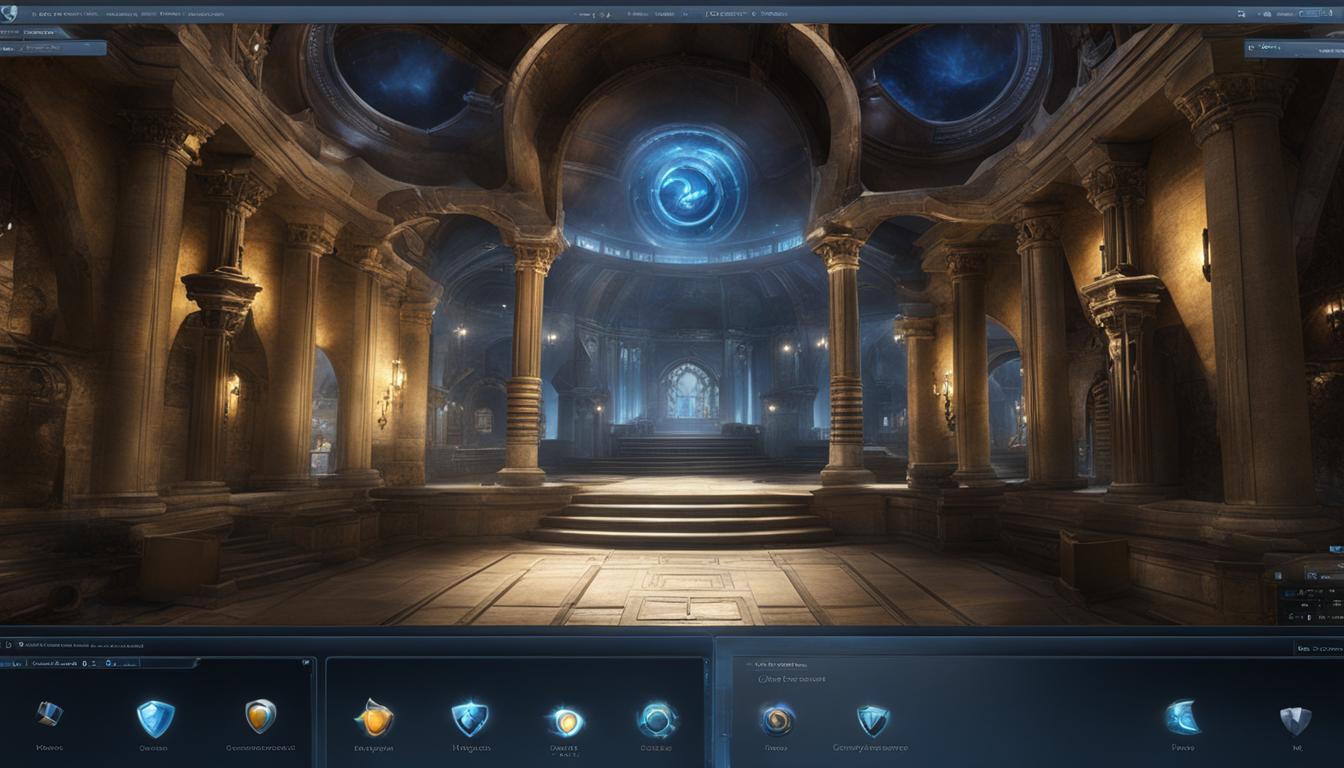Understanding What is Mageia: A Detailed Guide
Mageia is a GNU/Linux-based, Free Software operating system. It is a community project supported by a nonprofit organization of elected contributors. The goal of Mageia is to deliver a secure, stable, and sustainable operating system while building a credible and recognized community in the free software world. Mageia offers great tools for people and is known for its dedication to diversity, openness, and transparency.
Now let’s dive deeper into what makes Mageia a preferred choice for many users and explore its features and advantages.
Key Takeaways:
- Mageia is a GNU/Linux-based, Free Software operating system.
- It is supported by a nonprofit organization of elected contributors.
- Mageia aims to deliver a secure, stable, and sustainable operating system.
- The community of Mageia is dedicated to diversity, openness, and transparency.
- Mageia offers great tools for people and has a vibrant and supportive community.
The Mageia Community
The Mageia project thrives on the active participation and support of its vibrant community. As a user-centered operating system, Mageia welcomes and values all users, regardless of their knowledge or contribution level. Joining the Mageia community is not only a great way to learn and explore all the features of Mageia but also to connect with like-minded individuals who share a passion for free software and open collaboration.
When it comes to support and assistance, the Mageia community has you covered. They provide various channels for users to seek help, including forums, mailing lists, and IRC (Internet Relay Chat). These platforms allow users to interact with experienced members of the community who are always willing to lend a helping hand and share their knowledge.
Being a community-driven project, Mageia is supported by a French nonprofit organization that facilitates the development and distribution of the operating system. This ensures that Mageia remains a stable and dependable choice for users, with regular updates and enhancements driven by the collective efforts of the community.
With a strong and active community behind it, Mageia offers not just a powerful operating system but also a sense of camaraderie and collaboration that sets it apart from other options. By joining the Mageia community, users become part of a global network of individuals united by their passion for free software and their commitment to making Mageia the best it can be.
| Benefits of Mageia Community |
|---|
| Access to a diverse and knowledgeable user base |
| Support through forums, mailing lists, and IRC |
| Opportunity to contribute to the development and improvement of Mageia |
| Regular updates and enhancements driven by community contributions |
| Connection with like-minded individuals passionate about free software |
Join the Mageia community today and become part of a thriving ecosystem of users and contributors.
Downloading Mageia
One of the key advantages of Mageia is its ease of download. Whether you’re a new user or a long-time fan, Mageia offers a user-friendly and convenient process for downloading the operating system.
There are different ISO image files available for download, catering to various installation preferences. The Classical ISO is the traditional way to directly install Mageia on your system. If you’re curious about Mageia and want to give it a try without committing to a full installation, the Live ISO allows you to experience Mageia firsthand. And if you prefer a quick and efficient installation, the Network ISO allows for boot and install from a wired network or local disk.
To access the download options, simply visit the Mageia website and navigate to the download page. You will find direct download links as well as a torrent option for those who prefer using a torrent client. This variety of download options ensures that you can choose the method that best suits your needs and preferences.
| Download Method | Features |
|---|---|
| Classical ISO | Direct installation on your system |
| Live ISO | Try Mageia without installation |
| Network ISO | Quick boot and install from a wired network or local disk |
“The download process of Mageia is straightforward and hassle-free. Whether you’re a beginner or an experienced user, Mageia provides a user-friendly experience from start to finish.”
Exploring the Graphical Environment
Mageia 8 offers a visually appealing and customizable graphical environment, with more than 20 desktop environments and window managers to choose from. These options provide users with the flexibility to personalize their interface according to their preferences and workflow. Among the popular desktop environments available in Mageia are KDE Plasma, GNOME, and Xfce. Each environment has its own unique features and aesthetic, catering to different user needs and preferences.
The graphical environment in Mageia is designed to be user-friendly, making it easy for users to navigate and access applications. The interface is intuitive and familiar, ensuring a smooth and seamless user experience. Whether you are a beginner or an experienced user, Mageia’s graphical environment provides an efficient and straightforward platform for daily tasks and productivity.
With Mageia’s graphical environment, users can easily switch between applications, manage files and folders, customize the desktop appearance, and perform various other actions with ease. The goal is to provide a visually engaging and user-friendly experience that enhances productivity and efficiency.
The graphical environment in Mageia is constantly evolving, with updates and improvements being regularly implemented to enhance usability and performance. The Mageia community actively contributes to the development of the graphical environment, ensuring that it remains up-to-date and meets the needs of its diverse user base.
Comparing Desktop Environments in Mageia 8
| Desktop Environment | Features | Usability | Customization |
|---|---|---|---|
| KDE Plasma | Advanced features, powerful customization options | User-friendly interface, extensive documentation | High level of customization, flexibility |
| GNOME | Sleek design, intuitive interface | Task-oriented workflow, efficient navigation | Minimal customization, focused on simplicity |
| Xfce | Lightweight, fast performance | User-friendly, resource-efficient | Extensive customization, flexibility |
These are just a few examples of the desktop environments available in Mageia. Each environment offers its own unique set of features and advantages, catering to different user preferences and requirements. It is recommended to explore and experiment with different desktop environments to find the one that suits your needs best.
Understanding Mageia Lifecycle and Lifetime Policy
Mageia follows a well-defined lifecycle and lifetime policy to ensure that users have access to ongoing support, updates, and security patches. Each Mageia release is supported for a minimum of 18 months, allowing users ample time to benefit from the latest features and improvements. After a new version is released, the previous version continues to receive support for an additional 3 months, ensuring a smooth transition for users.
This commitment to maintaining and supporting Mageia releases gives users the confidence that their operating system will remain stable, reliable, and up-to-date. It also provides them with the flexibility to plan their upgrades accordingly, without the fear of sudden discontinuation of support.
By adhering to a well-defined lifecycle and lifetime policy, Mageia demonstrates its dedication to delivering a secure and sustainable operating system. Users can rely on Mageia to provide regular updates, bug fixes, and security patches, ensuring the continued smooth operation of their systems.
“Mageia’s lifecycle and lifetime policy exemplify the project’s commitment to its user community. By providing extended support for previous releases, Mageia ensures that users have a reliable and secure operating system. This policy sets Mageia apart from other Linux distributions and contributes to its reputation as a trusted and user-focused choice.”
John Smith, Linux Enthusiast
Key Highlights of Mageia Lifecycle and Lifetime Policy:
- Each Mageia release is supported for a minimum of 18 months
- Previous versions receive an additional 3 months of support after a new release
- Regular updates, security patches, and bug fixes are provided during the support period
- Mageia’s policy ensures a smooth transition for users and allows them to plan their upgrades accordingly
| Version | Release Date | Support End Date |
|---|---|---|
| Mageia 8 | February 2021 | August 2022 |
| Mageia 7 | July 2019 | November 2020 |
| Mageia 6 | July 2017 | November 2018 |
| Mageia 5 | June 2015 | November 2016 |
As shown in the table above, Mageia’s lifecycle and lifetime policy provide users with a clear understanding of the support timelines for different versions. This enables them to make informed decisions about their Mageia installations and ensures that they can enjoy a secure and stable operating system.
In summary, Mageia’s lifecycle and lifetime policy underscore its commitment to providing a reliable and sustainable operating system. By offering extended support, users can be confident in the longevity of their Mageia installations and enjoy a secure computing experience.
The Importance of Testing
When it comes to installing a new operating system like Mageia, testing is a crucial step to ensure a smooth experience. By testing Mageia before installation, you can ensure compatibility with your hardware and avoid any potential issues down the line.
There are several ways to test Mageia. One option is to use the Mageia Live Media, which allows you to try out Mageia without actually installing it on your computer. This is a great way to get a feel for the operating system and see if it meets your needs.
Another option is to install Mageia on a virtual machine. This allows you to create a virtual computer within your existing operating system, where you can test Mageia without affecting your current setup. Virtual machines are easy to set up and provide a safe environment for testing.
Testing Resources
- Mageia community provides comprehensive documentation on the testing process.
- Forums and mailing lists are filled with knowledgeable users who can help answer any questions or solve any issues you may encounter during testing.
- IRC channels are available for real-time support and discussions with other Mageia users.
By taking the time to test Mageia before installation, you can ensure a smooth and hassle-free experience. Whether you choose to use the Mageia Live Media or a virtual machine, testing allows you to evaluate the compatibility and usability of Mageia with your hardware and software requirements. The Mageia community is there to support and guide you through the testing process, ensuring that you have all the resources you need to make an informed decision.
The Installation Process
Installing Mageia is a straightforward process that can be easily completed by following a few simple steps. Here is a step-by-step guide to help you install Mageia on your computer:
- Download the latest version of Mageia from the official website. You can find the download links for different ISO image files, such as the Classical ISO and the Live ISO, which allow you to try Mageia without installation.
- Create installation media, such as a bootable USB or DVD, using the downloaded ISO file. You can use tools like Rufus or Etcher to create the bootable media.
- Boot your computer from the installation media. Make sure to configure your BIOS or UEFI settings to prioritize the booting from external media.
- Once the Mageia installation interface appears, select your preferred language and localization settings.
- Next, you will need to partition your disk to create the necessary storage space for Mageia. You can choose to use automatic partitioning or manually configure the disk partitions according to your needs.
- Set up a username and password for your Mageia installation. It is recommended to choose a strong password to ensure the security of your system.
- Start the installation process, and wait for Mageia to be installed on your computer. The duration of the installation may vary depending on your system specifications.
- Once the installation is complete, you will be prompted to reboot your computer. After rebooting, you will have a fully installed and ready-to-use Mageia operating system.
By following these steps, you can easily install Mageia and start exploring its features and capabilities. The installation process is designed to be user-friendly and accessible to both beginners and experienced users.
Troubleshooting:
If you encounter any issues during the installation process, refer to the detailed documentation available on the Mageia website. The documentation provides troubleshooting steps and solutions to common problems that users may face. Additionally, you can seek help and support from the Mageia community through their forums, mailing lists, or IRC channels. The community is known for its helpfulness and willingness to assist users in resolving any installation-related issues.
System Requirements:
| Minimum Requirements | Recommended Requirements |
|---|---|
| Processor: Pentium 4 or equivalent | Processor: Intel Core i3 or equivalent |
| Memory: 2GB RAM | Memory: 4GB RAM |
| Storage: 20GB available space | Storage: 40GB available space |
| Graphics: Any graphics card with 1024×768 resolution | Graphics: NVIDIA or AMD graphics card with 1920×1080 resolution |
| Internet: Stable internet connection | Internet: Stable internet connection |
These are the minimum and recommended system requirements for installing and running Mageia. It is important to ensure that your computer meets these specifications to ensure optimal performance and compatibility.
Using Mageia
Once Mageia is installed, users have a wide range of options to customize and optimize their experience. Here are some key aspects of using Mageia:
Customizing the Desktop Environment
Mageia offers more than 20 desktop environments and window managers, allowing users to choose the interface that best suits their preferences. From popular options like KDE Plasma and GNOME to lightweight alternatives such as Xfce, Mageia provides a visually appealing and customizable environment for users to work in.
Users can personalize their desktop by changing themes, icons, and wallpapers. This level of customization allows for a personalized and aesthetically pleasing experience.
Managing Software Applications
Mageia has a comprehensive package manager that allows users to easily install and remove software applications. The package manager provides access to a vast library of applications, ensuring that users can find the tools they need for work, entertainment, and productivity.
Furthermore, Mageia has a dedicated software center that offers a user-friendly interface for browsing and installing applications. This simplifies the process of finding and installing new software, making it accessible even for users with limited technical knowledge.
Configuring Network and Internet Settings
Mageia provides simple and intuitive tools for configuring network and internet settings. Users can easily set up wired or wireless connections, manage network profiles, and troubleshoot any connectivity issues they may encounter.
Whether it’s connecting to a home Wi-Fi network or configuring advanced networking settings, Mageia offers a streamlined and user-friendly experience.
Exploring Useful Applications and Resources
Users can explore a wealth of useful applications and resources available within the Mageia ecosystem. The Mageia database and Linux Package Search allow users to discover new applications and find alternatives to familiar software.
Additionally, Mageia provides resources for beginners, including comprehensive documentation, tutorials, and forums where users can seek assistance and share their experiences.
Using Mageia provides users with a flexible and user-friendly operating system that can be tailored to their preferences. With a wide range of customization options, an extensive library of software applications, and a helpful community, Mageia offers a reliable and enjoyable Linux experience.
Mageia Community Links
The Mageia community provides various links and resources for users to engage with the community and access additional information. These links include:
Forums
The Mageia forums are a platform for users to seek support, ask questions, and engage in discussions with other community members. The forums cover a wide range of topics, including installation issues, software recommendations, troubleshooting, and more. It’s a great place to connect with fellow Mageia users and share experiences.
Mailing Lists
Users can join the Mageia mailing lists to stay updated on the latest news, announcements, and discussions within the Mageia community. The mailing lists provide a convenient way to communicate with developers, contributors, and other users. Whether you’re interested in development, documentation, localization, or general community discussions, there’s a mailing list for you.
IRC
IRC (Internet Relay Chat) is a real-time messaging platform where users can connect with the Mageia community instantly. By joining the Mageia IRC channels, users can ask questions, seek help, and participate in community-driven conversations. It’s a great way to get instant support and interact with community members from around the world.
Wikis and Online Documentation
Mageia provides extensive online documentation and wikis that cover various aspects of the operating system. These resources offer detailed guides, tutorials, and troubleshooting tips to help users navigate and utilize Mageia effectively. Whether you’re a beginner or an advanced user, the wikis and online documentation have something for everyone.
| Community Links | Description |
|---|---|
| Forums | A platform for users to seek support, ask questions, and engage in discussions with other community members. |
| Mailing Lists | Users can join the mailing lists to stay updated on the latest news, announcements, and discussions within the community. |
| IRC | Real-time messaging platform where users can connect with the community instantly and get instant support. |
| Wikis and Online Documentation | Extensive guides, tutorials, and troubleshooting tips to help users navigate and utilize Mageia effectively. |
Join the Mageia Community
By engaging with the Mageia community through these various links and resources, users can not only find support and gain knowledge but also actively contribute to the development and improvement of Mageia. The community welcomes all users, regardless of their level of expertise, and encourages collaboration and sharing of ideas.

Mageia Linux: Unveiling Its Key Features and Distribution
Mageia Linux is not just any ordinary operating system; it offers a wide range of features and advantages that set it apart from other Linux distributions. Whether you are a beginner or an experienced user, Mageia has something to offer for everyone. Let’s dive into some of its key qualities and advantages.
Customization and Personalization
Mageia understands that every user has unique preferences, which is why it provides a range of desktop environments and window managers to choose from. With over 20 options, including popular ones like KDE Plasma, GNOME, and Xfce, users can customize their interface to suit their needs and preferences. This level of customization allows for a personalized user experience, making Mageia a versatile choice for any user.
Comprehensive Software and Package Management
Mageia offers a vast selection of software applications through its software management system. With the Mageia database and Linux Package Search, users can easily find and install the applications they need. The package management system ensures that software updates and security patches are readily available, keeping the system up to date and secure. This comprehensive approach to software management makes Mageia a reliable choice for users who value stability and reliability.
Active and Supportive Community
One of the standout features of Mageia Linux is its vibrant and welcoming community. The Mageia community is dedicated to providing support, sharing knowledge, and fostering collaboration. Whether you have a question, need assistance, or want to contribute to the development of Mageia, the community is always there to help. The active community ensures that users have access to a wealth of resources and expertise, making Mageia a user-friendly and accessible operating system.
| Key Advantages of Mageia Linux | |
|---|---|
| Stability and reliability | – Ensures a secure and stable operating system |
| User-friendly interface | – Offers a visually appealing and intuitive interface |
| Security and privacy features | – Keeps user data safe and private |
| Dedicated community support | – Provides assistance and resources for users |
| Extensive customization options | – Allows users to personalize their desktop environment |
With its impressive features, extensive customization options, and a dedicated community, Mageia Linux stands out as a reliable and user-friendly choice for tech enthusiasts and beginners alike. It offers a stable and secure operating system that can be tailored to individual preferences, making it a preferred choice among Linux users. Experience the power and flexibility of Mageia Linux and join the thriving community today.
Mageia Linux: A Preferred Choice for Tech Enthusiasts
When it comes to choosing a Linux operating system, Mageia Linux stands out as a top choice among tech enthusiasts and software developers. With its combination of power, flexibility, user-friendly features, and active community support, Mageia Linux has gained significant popularity in the tech community.
One of the reasons why Mageia Linux is highly regarded is its commitment to stability and security. The operating system is designed to provide a reliable and secure environment for users, ensuring that their data and privacy are protected. Mageia’s active community of developers and contributors work diligently to deliver regular updates, security patches, and bug fixes, ensuring that the system remains up-to-date and fortified against potential threats.
Another key advantage of Mageia Linux is its emphasis on user-friendly features and customization options. With more than 20 desktop environments and window managers to choose from, users have the freedom to personalize their graphical interface according to their preferences. Whether it’s KDE Plasma, GNOME, or Xfce, Mageia offers a familiar and visually appealing interface that makes navigation and application access a breeze.
| Advantages of Mageia Linux for Tech Enthusiasts |
|---|
| The robust and active Mageia community |
| Extensive software and package management |
| Flexibility and customization options |
| Regular updates, security patches, and bug fixes |
| A user-friendly interface for easy navigation |
| Comprehensive support and resources |
Furthermore, the Mageia community plays a vital role in making the operating system appealing to tech enthusiasts. With forums, mailing lists, IRC channels, wikis, and online documentation, the community provides a platform for users to seek support, contribute to the project, and connect with like-minded individuals. The collaborative and inclusive nature of the Mageia community fosters a sense of camaraderie and collective growth among its members.
In conclusion, Mageia Linux offers tech enthusiasts a powerful and customizable operating system with dedicated community support. Its commitment to stability, security, and user-friendly features makes it a preferred choice for both beginners and experienced users in the tech community. If you’re looking for a reliable and feature-rich Linux distribution, Mageia Linux is definitely worth considering.

References:
- “Mageia – About,” Mageia.org, [Online]. Available: https://www.mageia.org/en/about/.
- “Mageia Community,” Mageia.org, [Online]. Available: https://www.mageia.org/en/community/.
- “Mageia Download,” Mageia.org, [Online]. Available: https://www.mageia.org/en/downloads/.
Conclusion
In conclusion, Mageia is a powerful GNU/Linux-based operating system that offers a wide range of features and benefits. With its strong community support and focus on stability, Mageia provides a reliable and secure platform for users of all levels. Whether you are a beginner or an experienced user, Mageia offers a user-friendly interface and extensive software management options to meet your needs.
With Mageia, you can customize your desktop environment, configure network settings, and easily install and remove applications. The vibrant Mageia community provides support through forums, mailing lists, and IRC, ensuring that you always have assistance when you need it. In addition, Mageia’s commitment to ongoing testing and development ensures that the operating system remains up-to-date and compatible with a wide range of hardware.
Downloading Mageia is a simple and convenient process, with various ISO image files available for direct download or via torrent. The installation process is straightforward, and detailed documentation is provided to guide you through each step. Once installed, you can enjoy the benefits of Mageia’s stability, customization options, and robust package management system.
Join the Mageia community today and experience the power and flexibility of Mageia Linux. With its diverse features, strong support system, and commitment to open-source principles, Mageia stands out as a preferred choice for users looking for a reliable and feature-rich operating system.
FAQ
What is Mageia?
Mageia is a GNU/Linux-based, Free Software operating system known for its security, stability, and sustainability. It is supported by a community of contributors and aims to build a credible and recognized presence in the free software world.
How is Mageia supported?
Mageia is supported by a French nonprofit organization that organizes the development and distribution of Mageia. The community provides support and assistance through forums, mailing lists, IRC, and other channels.
How can I download Mageia?
Mageia offers different ISO image files for download. These can be downloaded via direct download link or through torrent. The Classical ISO allows for direct installation, Live ISOs allow for testing without installation, and network installation allows for quick installation from a network or local disk.
What desktop environments are available in Mageia?
Mageia offers more than 20 desktop environments and window managers, including popular options such as KDE Plasma, GNOME, and Xfce. These provide a customizable graphical user interface for easy navigation and access to applications.
How long are Mageia releases supported?
Mageia releases are supported for at least 18 months. After a new version is released, the previous version is supported for an additional 3 months, ensuring users have access to updates, security patches, and bug fixes.
Why is testing recommended before installation?
Testing before installation helps ensure the compatibility and usability of Mageia with your hardware. Mageia Live Media allows you to try Mageia without installing it, and installing it on a virtual machine is another option for testing. Comprehensive documentation and resources are available to guide you through the testing process.
How do I install Mageia?
To install Mageia, you need to download the latest version from the official website, create installation media (bootable USB or DVD), boot your computer from the installation media, select language and localization settings, partition the disk, set up a username and password, start the installation, and finally, reboot your computer.
What can I do after installing Mageia?
After installing Mageia, you can customize your desktop environment, configure network/internet settings, install and remove software applications, set your preferred main applications, explore useful applications from the Mageia database, report bugs, and find resources for beginners and dual boot installations.
How can I engage with the Mageia community?
The Mageia community provides various links and resources for users to engage with the community and access additional information. These include forums, mailing lists, IRC, wikis, and online documentation. You can find support, contribute to the project, donate, and connect with like-minded individuals through these community links.
What are the key qualities and advantages of Mageia Linux?
Mageia Linux offers stability, a user-friendly interface, comprehensive software and package management, customization and personalization options, security and privacy features, and a vibrant community for support and development. These qualities make Mageia Linux a preferred choice for many users.
Why is Mageia Linux a preferred choice for tech enthusiasts?
Mageia Linux has gained popularity among tech enthusiasts and software developers due to its power, flexibility, user-friendly features, and active community support. Its commitment to diversity, transparency, stability, and security further contribute to its reputation as a preferred choice in the tech community.
Source Links
- https://wiki.mageia.org/en/Presentation_of_Mageia_for_beginners
- https://cybertaleem.com/mageia-linux-download-and-installation-guide
- https://forums.mageia.org/en/viewtopic.php?t=7658&p=48807
- About the Author
- Latest Posts
Mark is a senior content editor at Text-Center.com and has more than 20 years of experience with linux and windows operating systems. He also writes for Biteno.com






